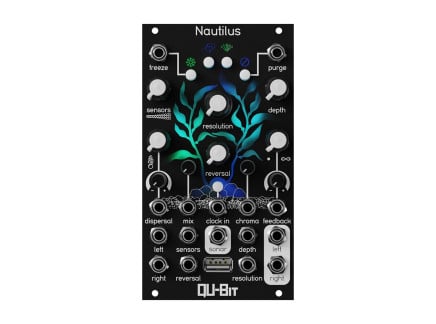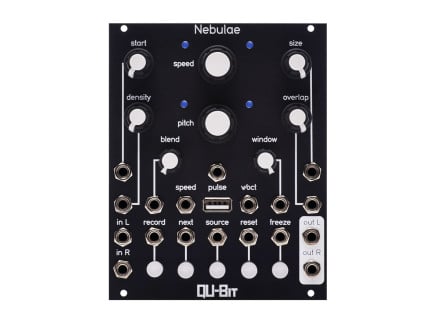Qu-Bit Electronix has introduced their latest Eurorack module, Mojave: a fully stereo, live granular processor inspired by the swarming, particulate sounds of sandstorms. Designed to bring extensive control of live granular sampling processes to modular synthesizers, Mojave provides an exploratory approach to sound design and performance. It can be explosive and chaotic; it can be textural; it can by rhythmic; it can be harmonic; it can be dang near anything that you could imagine granular synthesis to be.
Of course, Qu-Bit is no stranger to granular synthesis—in fact, they were one of the first companies to develop granular synthesis hardware altogether. In the early 2010s, they introduced the world to Nebulæ, a granular sampler intended to bring some of the most exciting, cutting edge sounds of computer music research into the hands of creative musicians. In many ways, it brought an entirely new sonic palette to modular synthesis and hardware as a whole...cementing Qu-Bit's reputation as a creative and forward-thinking force in electronic instrument development. Later, the Nebulae V2 expanded on its predecessor by providing built-in audio recording, stereo I/O, and a refined user interface.
In the years since, Qu-Bit has produced an endless supply of new tools for Eurorack modular synthesizers—constantly bringing the best and most interesting aspects of cutting-edge computer music to hardware format. In recent years, they also assisted in the development of the Daisy DSP platform...a hardware development platform specifically designed for electronic musical instruments. Since, their most notable releases have explored a new, refined workflow based around the Daisy—with releases like the Aurora spectral reverb, Nautilus delay network, and now, the Mojave stereo live granular processor taking advantage of the Daisy's unique possibilities.
As you might realize, many of us at Perfect Circuit love computer music, open-source hardware, and modular synthesizers...so, we're always excited to learn about a new Qu-Bit release. As such, we reached out to Qu-Bit founder, CEO, and designer Andrew Ikenberry to talk about Mojave. Andrew filled us in on its development—from initial conception to finished product—and pondered its place within the Qu-Bit lineup and Eurorack modular synthesizers as a whole. Best of all, he talked about some of his favorite ways to use Mojave.
If you want a glimpse into the processes and design considerations that go into making new electronic instruments, read on.
Making Mojave: an Interview with Qu-Bit's Andrew Ikenberry
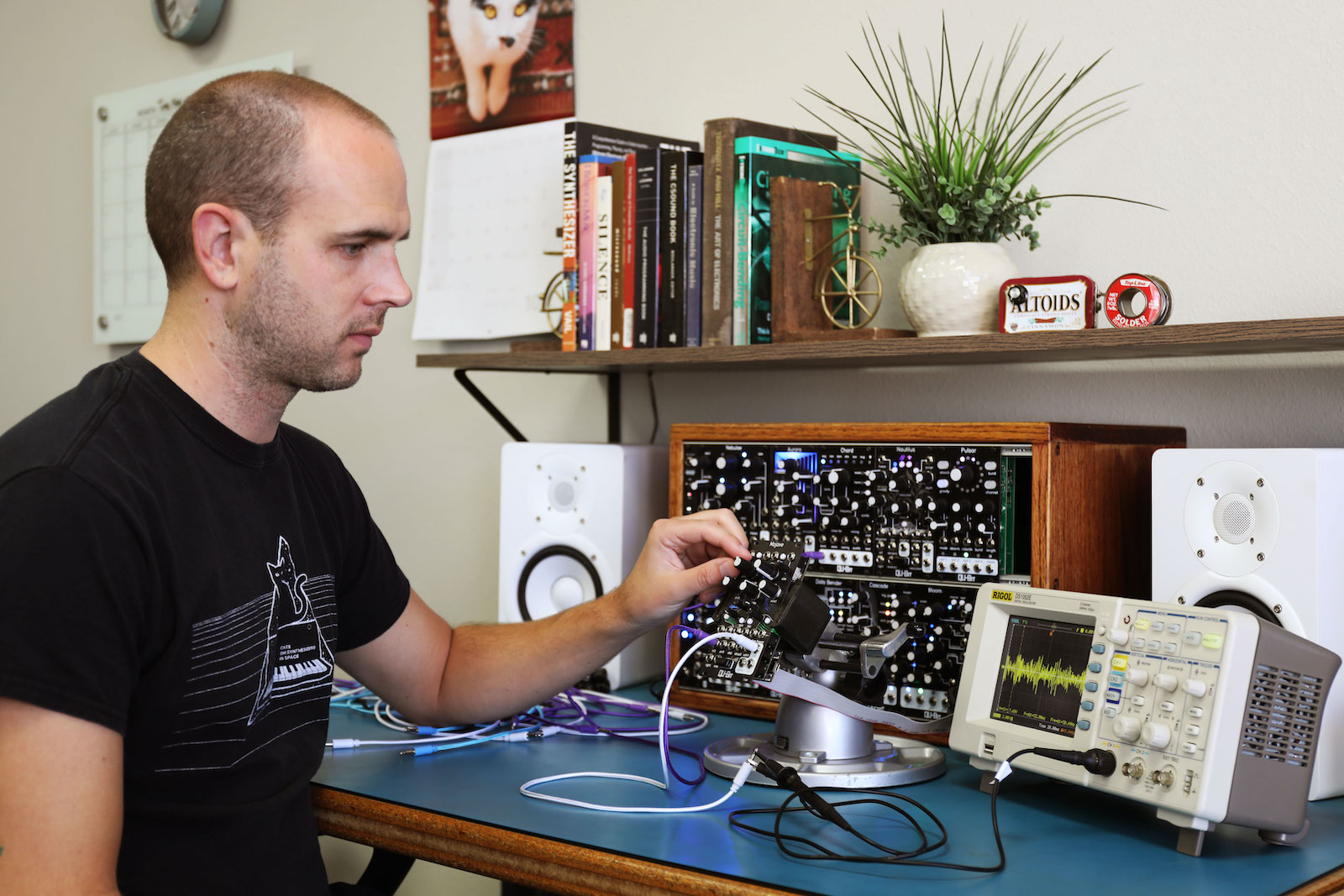
[Above: Qu-Bit founder & designer Andrew Ikenberry with his newest module, Mojave.]
Perfect Circuit: Mojave isn't Qu-Bit's first foray into granular synthesis. In fact, granular synthesis has been a part of Qu-Bit from the very beginning with the release of the original Nebulae. What made granular synthesis the right territory to explore as you were just getting started with Eurorack design?
Andrew Ikenberry: Granular synthesis has always resonated with Qu-Bit’s design philosophy. Our goal from the beginning has been to implement novel DSP techniques in hardware. When you think about the most exciting algorithms to come from the computer music world over the last 50 years, granular synthesis has to be close to the top. From that perspective, it was a natural choice of inspiration for a Qu-Bit module design.
PC: When you revisited Nebulae and released Nebulae V2—what changed? Had your thoughts about granular synthesis evolved? Did you try out any new ideas in Nebulae V2, regarding the granular algorithm or parameterization?
AI: The primary difference between the v1 and v2 Nebulae was that we added audio inputs on the v2. The original Nebulae was just a sample player, but we always wanted to give users the ability to record live audio in from their modular, and process that using the same techniques that made the original Nebulae so exciting.
[Above: Qu-Bit's all-new granular audio processor module, Mojave.]
PC: Of course, Mojave is your most recent granular-based endeavor. How does Mojave differ from Nebulae V1 and V2?
AI: Mojave excels at live granular processing as opposed to recorded buffers, and the workflow reflects this. Just plug in a signal and it will start granularizing it immediately. This creates a very plug and play, hands-on type of interface which feels more like an effects unit than a traditional looper style sampler.
PC: Beyond the Nebulae, there are a lot of stellar granular synthesis modules out there. Eurorack is such a unique creative space that competition probably isn't a big concern—but how did it feel to design something new, now that granular hardware is so much more common than when Nebulae V1 and V2 were originally developed? What does Mojave uniquely excel at doing within the realm of granular synthesis?
AI: It’s always exciting to see new releases from other designers because it raises the bar and inspires us to improve on our own designs the next time around. This has been especially true on Mojave.
One of the areas that it stands apart from other granular offerings is that we’ve added an element of musical control to the randomly generated parameters. For example, the random pitch modulation generated by the Structure knob features built-in quantization so that your grains can always be in tune with the rest of your patch.
Similarly, the Distribute knob, which applies random deviation to the timing of grains, can be synced to the current clock rate, and can even apply ratchets and rhythmic glitching which are still in time with the rest of your patch.
PC: Following the trend established with Aurora and Nautilus, Mojave features beautiful graphics illuminated by LEDs behind the panel. But this isn't just a colorful light show—Mojave conveys useful information such as grain size and playback position through this UI. How does this approach to functional aesthetics affect your design process? Do you start with strong functional code first? Or do visual imagery and concepts inspire you to think differently about audio processing code?
AI: We like to base our product design on an overarching concept. This helps us make important design decisions because it provides a mental framework to work within.
For Mojave, inspiration struck when I experienced a dust storm in Joshua Tree. This event helped me connect the dots between the desert environment and granular synthesis. I was extremely inspired by the sound of sand hitting the windows of the place I was staying at. The wind gusts would drive varying amounts of sand into the glass, which would in turn create a multitude of different textures of sound. As the wind speed increased or decreased so would the corresponding root pitch of the sounds. This became the groundwork for the different controls on Mojave and is also what data animates the LEDs on the user interface.
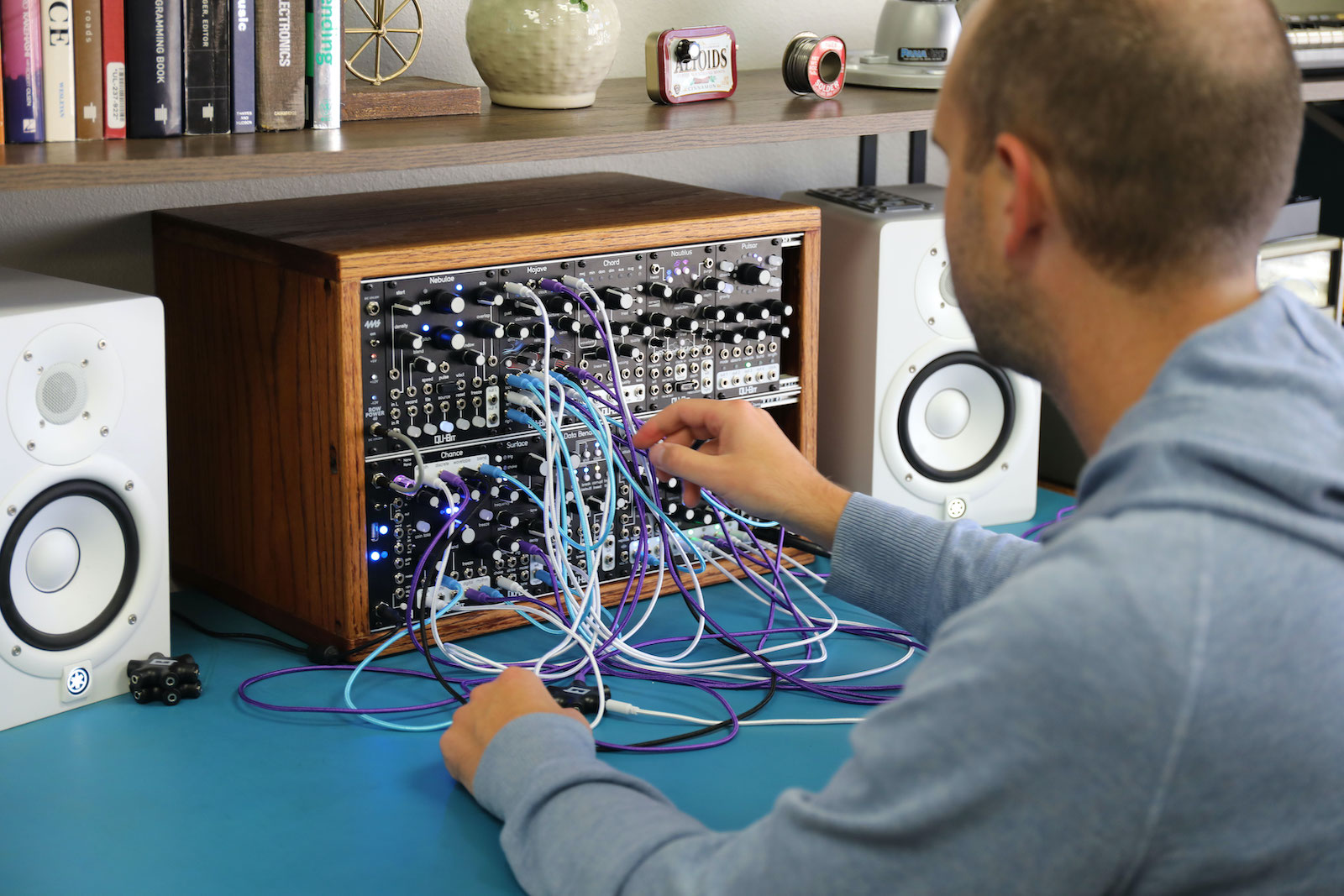
[Above: Andrew Ikenberry testing Mojave amongst a system of other contemporary Qu-Bit modules.]
PC: Beyond the aesthetic aspect of Mojave, certain parameter and mode names play into the desert theme as well. With names like Drift, Whirl, and Gust, visual names can help to understand what a knob or button might do, while others use the technical, "vanilla" name. Was there a process for deciding which controls got a thematic name vs. more direct titles? And for those with names that you've created, did you aim to stay relatively synonymous with standard parameter names?
AI: We’re always careful with parameter names because we want the module to be easy to use, but at the same time we want to keep the user in the proper mental space for using the module. For example, Whirl is a really unique control on Mojave which adds random panning and stereo positioning to the audio outputs. It made the most sense to give this knob a name that stems from our design process since it performs a function which is so unique to Mojave.
On the other hand, we didn’t want to call the Rate knob something other than rate, because the word itself doesn’t take us out of the desert landscape mentally, and another term for that knob would make the module more difficult to use.
PC: Granular synthesis, especially in software formats, can have expansive and open-ended parameterization, with no right or wrong approach. With Mojave, how did you determine which parameters would get direct control? What typical granular parameters got grouped into macro controls or left out entirely?
AI: We made a delineation between direct and macro controls based on which parameters normally need to be modulated in order to create exciting sounds. One problem that we wanted to solve with Mojave was that granular synthesis when not modulated can sound static, and boring.
To fix this, we created five macro controls which do things we internally like to call “auto-magic”. Auto-magic controls are parameters which apply built in modulation to static controls. For example, Whirl applies random panning to your audio outputs, Structure applies random pitch modulation, and Distribute applies random time deviation to each grain. These knobs provide an exciting, dynamic implementation of granular synthesis which is why we made these the primary controls with the largest knobs.
PC: I think a lot of folks associate granular synthesis, or at least granular delay and processor modules, with shimmering ambient patches. But granular synthesis can be gnarly, gritty, and rhythmic too! Mojave seems like it can do both as well as anything in between—how have you leveraged Mojave's parameters and modes for patches in these styles?
AI: We always try to keep in mind both sides of the coin when it comes to design. I think modules should do one thing well, but they should also be flexible enough to handle multiple musical styles. The Mojave is really exemplary of this philosophy because it can take on both the pretty, ambient side of things, while also getting extremely aggressive.
A perfect example of this is the Gust control. When you’re on the right side of the knob, it adds a beautiful end of chain reverb, but if you’re on the left side, it will crank the feedback to the point where you can remove any audio inputs and create full on harsh noise.
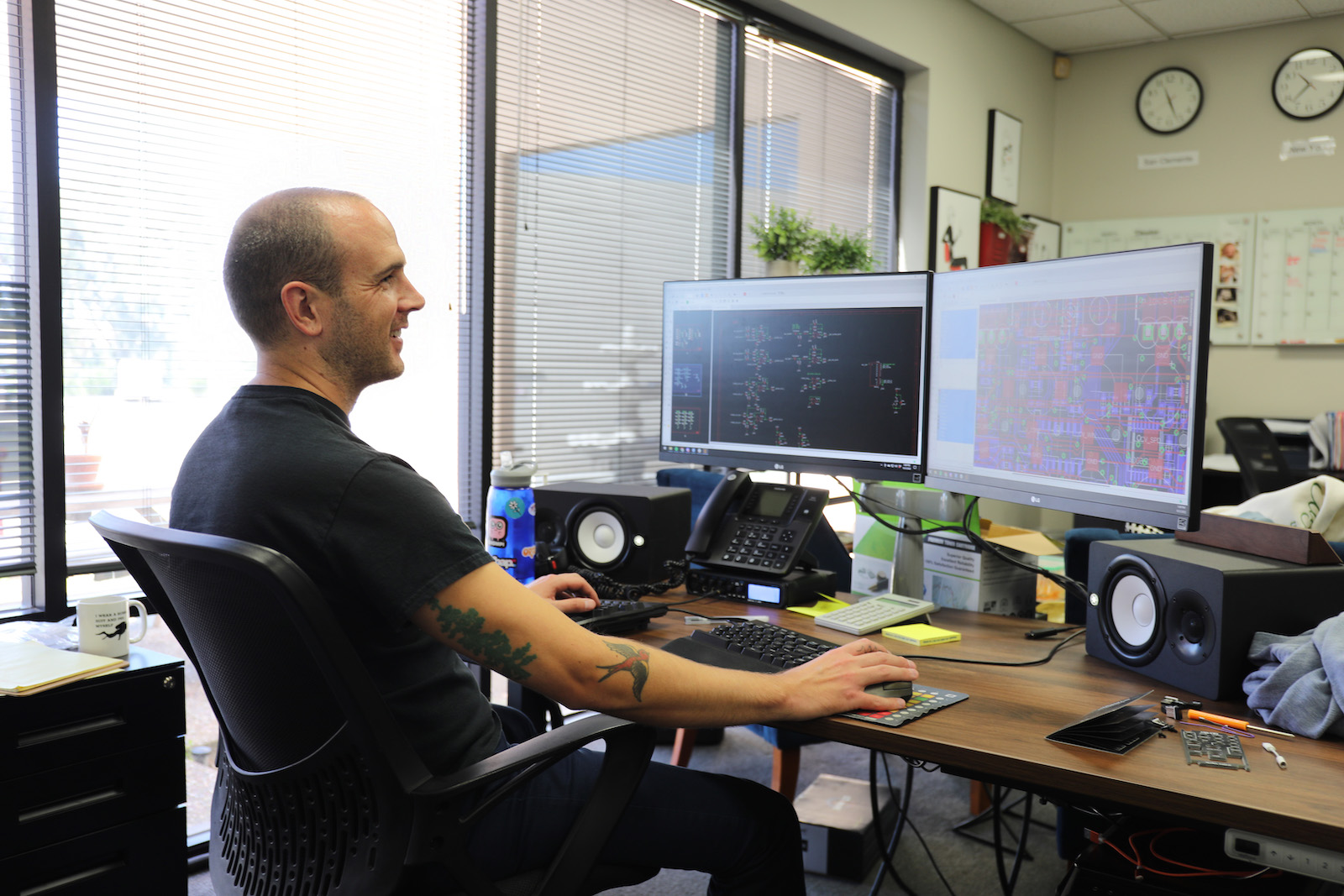
[Above: Andrew Ikenberry at work on PCB layout.]
PC: Tell us about the Dune output—we're big fans of control voltage outputs on modules that aren't otherwise dedicated to the task of modulation. Do you enjoy self-patching Mojave with signals from its Dune output? Any pairings with other modules that you really like?
AI: The Dune output is honestly one of my favorite jacks on Mojave! I’ve found that modular synthesis works best when there’s a synergy between the different modules in your system. The more interconnected your patch is, the more magic that’s going to happen. Dune is really special because you can map the goings-on of your granular processor to control data elsewhere in your patch.
And perhaps even more powerful than that, you can self-patch the Dune output to create all sorts of wild patterns. One patch that I really love is locking the audio buffer, and using the Dune output as a reset signal which turns Mojave into a unique looper. If you self-patch the Dune output to Zone CV in, the Dune modulation becomes your playhead position within the buffer. With all macro knobs knobs down on Mojave, Dune will output a smooth ramp wave which creates a very straight forward looper. As you move the knobs around, your looper will move in erratic ways which is really magical for live audio sampling. This patch, in combination with injecting new audio via the microphone, is so much fun!
PC: A long-running tradition for select Qu-Bit products, including Mojave, Aurora, and Nebulae, is to support alternate and even user-written firmware. How did this feature come about? Is it important to you to provide this sort of out-of-the-box hackability in your products?
AI: My first forays into programming were using open source languages such as Csound and SuperCollider, which really instilled a passion for open source software. And since Qu-Bit modules are digital, I’ve always valued the idea that users can customize the product to their heart’s content. Modular users tend to know exactly what they’re looking for, so why not empower them to customize their gear?
This philosophy has actually boiled over into a new concept which we’re calling Narwhal—our new web editor for Qu-Bit products. This website lets users choose their own settings for each of our modules without writing any code. On Mojave you can select different Mix knob curves, quantization settings and more. Once you choose your settings on the webpage, simply place the exported file onto your flash drive and load it into Mojave to try out the new settings!
[Above: Mojave PCB assembly underway.]
PC: Mojave, like Nautilus and other Qu-Bit modules before it, is based on the Electro-Smith Daisy DSP platform. Normally we'd ask some general questions about developing for Daisy, but of course, you are the CEO of Electro-Smith and a key developer of Daisy's hardware and software components. Did Daisy grow out of your own desires while designing Qu-Bit modules? How has it changed the way you design and prototype Eurorack modules?
AI: The first module I ever designed was based on the Raspberry Pi platform. I quickly realized that even though the Pi is awesome, it’s not an ideal way to build audio hardware. This inspired me to take the digital audio technology that we had developed on Qu-Bit modules, and deploy it into a reusable form factor which other companies can use as well.
It completely changed the way that we think about hardware design. The biggest change is that it sped up our development time and allowed us to focus primarily on firmware development and how the module functions, rather than PCB design. Ultimately, this leads to much better products with a shorter development cycle.
PC: Daisy has been adopted by so many different instrument designers in Eurorack and beyond. What is it like to see Daisy-based products released from both established companies as well as newcomers empowered by such a streamlined path into hardware development?
AI: It has been an incredible thing to watch! I’m always amazed at the creative things people make with the Daisy platform. It’s also been nice to see Daisy become something that users can recognize and trust for high quality digital audio hardware. At the end of the day, each new Daisy-based product which is released creates a rising tide for all Daisy-based products. We are able to devote more resources to the Daisy codebase, and platform at large which improves not just the developer experience but the Eurorack user experience as well. I can’t wait to see how this continues to unfold over the next couple years as more and more products are released with Daisy under the hood.
The Granular Details
Qu-Bit continues to innovate—and it's refreshing to see them present a new take on granular synthesis. Mojave no doubt presents a unique take on the technique. With its thematic approach to parameterization, it will no doubt guide users into new sonic territory. Whether you're looking for a dynamic looping tool, gestural granular mayhem, or evolving ambient textures, Mojave might just be the right thing for the job.








